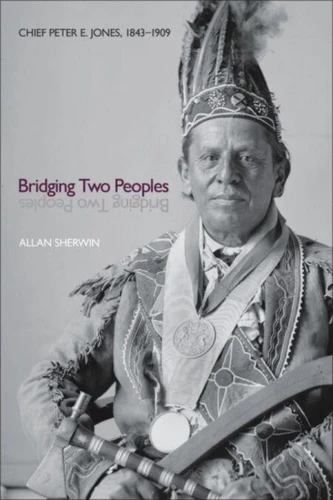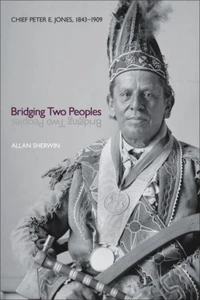Bridging Two Peoples. Chief Peter E. Jones, 1843–1909
Par :Formats :
Disponible dans votre compte client Decitre ou Furet du Nord dès validation de votre commande. Le format ePub est :
- Compatible avec une lecture sur My Vivlio (smartphone, tablette, ordinateur)
- Compatible avec une lecture sur liseuses Vivlio
- Pour les liseuses autres que Vivlio, vous devez utiliser le logiciel Adobe Digital Edition. Non compatible avec la lecture sur les liseuses Kindle, Remarkable et Sony
 , qui est-ce ?
, qui est-ce ?Notre partenaire de plateforme de lecture numérique où vous retrouverez l'ensemble de vos ebooks gratuitement
Pour en savoir plus sur nos ebooks, consultez notre aide en ligne ici
- Nombre de pages270
- FormatePub
- ISBN978-1-55458-653-0
- EAN9781554586530
- Date de parution01/06/2012
- Protection num.Digital Watermarking
- Taille4 Mo
- Infos supplémentairesepub
- ÉditeurWilfrid Laurier University Press
Résumé
Bridging Two Peoples tells the story of Dr. Peter E. Jones, who in 1866 became one of the first status Indians to obtain a medical doctor degree from a Canadian university. He returned to his southern Ontario reserve and was elected chief and band doctor. As secretary to the Grand Indian Council of Ontario he became a bridge between peoples, conveying the chiefs' concerns to his political mentor Prime Minister Sir John A.
Macdonald, most importantly during consultations on the Indian Act. The third son of a Mississauga-Ojibwe missionary and his English wife, Peter E. Jones overcame paralytic polio to lead his people forward. He supported the granting of voting rights to Indians and edited Canada's first Native newspaper to encourage them to vote. Appointed a Federal Indian Agent, a post usually reserved for non-Natives, Jones promoted education and introduced modern public health measures on his reserve.
But there was little he could do to stem the ravages of tuberculosis that cemetery records show claimed upwards of 40 per cent of the band. The Jones family included Native and non-Native members who treated each other equally. Jones's Mississauga grandmother is now honoured for helping survey the province of Ontario. His mother published books and his wife was an early feminist. The appendix describes how Aboriginal grandmothers used herbal medicines and crafted surgical appliances from birchbark.
Macdonald, most importantly during consultations on the Indian Act. The third son of a Mississauga-Ojibwe missionary and his English wife, Peter E. Jones overcame paralytic polio to lead his people forward. He supported the granting of voting rights to Indians and edited Canada's first Native newspaper to encourage them to vote. Appointed a Federal Indian Agent, a post usually reserved for non-Natives, Jones promoted education and introduced modern public health measures on his reserve.
But there was little he could do to stem the ravages of tuberculosis that cemetery records show claimed upwards of 40 per cent of the band. The Jones family included Native and non-Native members who treated each other equally. Jones's Mississauga grandmother is now honoured for helping survey the province of Ontario. His mother published books and his wife was an early feminist. The appendix describes how Aboriginal grandmothers used herbal medicines and crafted surgical appliances from birchbark.
Bridging Two Peoples tells the story of Dr. Peter E. Jones, who in 1866 became one of the first status Indians to obtain a medical doctor degree from a Canadian university. He returned to his southern Ontario reserve and was elected chief and band doctor. As secretary to the Grand Indian Council of Ontario he became a bridge between peoples, conveying the chiefs' concerns to his political mentor Prime Minister Sir John A.
Macdonald, most importantly during consultations on the Indian Act. The third son of a Mississauga-Ojibwe missionary and his English wife, Peter E. Jones overcame paralytic polio to lead his people forward. He supported the granting of voting rights to Indians and edited Canada's first Native newspaper to encourage them to vote. Appointed a Federal Indian Agent, a post usually reserved for non-Natives, Jones promoted education and introduced modern public health measures on his reserve.
But there was little he could do to stem the ravages of tuberculosis that cemetery records show claimed upwards of 40 per cent of the band. The Jones family included Native and non-Native members who treated each other equally. Jones's Mississauga grandmother is now honoured for helping survey the province of Ontario. His mother published books and his wife was an early feminist. The appendix describes how Aboriginal grandmothers used herbal medicines and crafted surgical appliances from birchbark.
Macdonald, most importantly during consultations on the Indian Act. The third son of a Mississauga-Ojibwe missionary and his English wife, Peter E. Jones overcame paralytic polio to lead his people forward. He supported the granting of voting rights to Indians and edited Canada's first Native newspaper to encourage them to vote. Appointed a Federal Indian Agent, a post usually reserved for non-Natives, Jones promoted education and introduced modern public health measures on his reserve.
But there was little he could do to stem the ravages of tuberculosis that cemetery records show claimed upwards of 40 per cent of the band. The Jones family included Native and non-Native members who treated each other equally. Jones's Mississauga grandmother is now honoured for helping survey the province of Ontario. His mother published books and his wife was an early feminist. The appendix describes how Aboriginal grandmothers used herbal medicines and crafted surgical appliances from birchbark.




